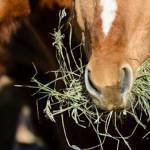Saliva Production and Function in the Horse

Like humans, horses produce saliva primarily to moisten and soften food, which in turn eases its passage from the mouth through the esophagus and into the stomach.
Three pairs of salivary glands produce saliva, though the parotid gland, which is situated in the space between the mandible and the wing of the first vertebra, outproduces the other pairs substantially. Daily saliva production by the parotid in an average horse is estimated to be 12 liters (3 gallons). Unlike humans and certain other mammals, saliva secretion only occurs during chewing.
Gastric tissues that are well bathed in saliva are thought to be less predisposed to ulceration. This accounts for the general feeding guideline that suggests round-the-clock access to forage, the quality of which can be determined based on the horses being fed (an overweight adult horse that performs little work can consume mid-quality hay but a broodmare in the second month of lactation might require something more nutritious).
Few disorders of the salivary glands have been noted. Because of the high concentration of calcium, salivary ducts can sometimes be obstructed by calculi, but occurrence is rare.
More common among horse is hypersalivation, and this is almost always caused by ingestion of the fungus Rhizoctonia leguminicola, which causes black patch diseases in stands of red clover. This fungus produces slaframine. Ingestion of slaframine stimulates secretion of saliva, sometimes to the point that copious amounts escape the mouth when opened. This may be particularly noticeable when horses are opening their mouths to accept a bit or when an oral medication is given.
Slaframine toxicosis usually occurs in the spring and summer. Eradication of the fungus can usually be accomplished through regular mowing, as regrowth tends to harbor less of the fungus.








